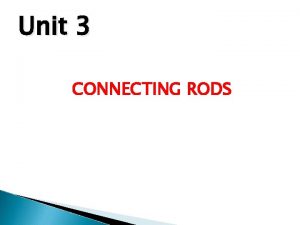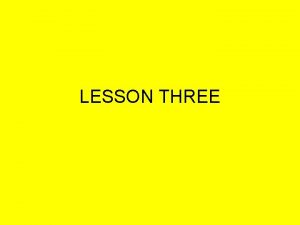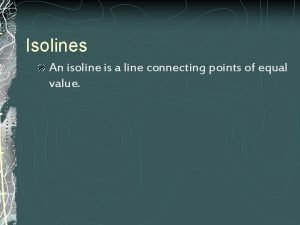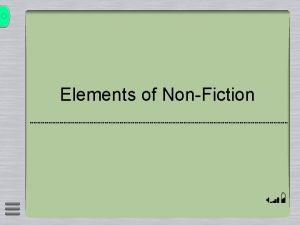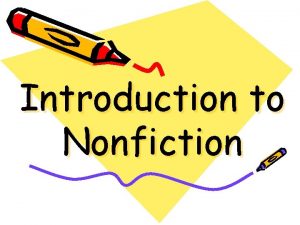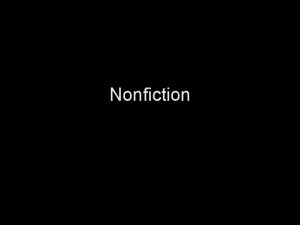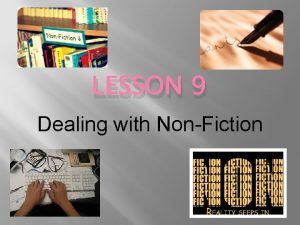Reading Nonfiction Connecting to Information What Is Nonfiction












- Slides: 12

Reading Nonfiction Connecting to Information

What Is Nonfiction? Nonfiction is prose writing that deals with real people, things, events, and places. • Nonfiction writing includes • essays and histories • biographies and autobiographies • letters and diaries • how-to writings • scientific reports • encyclopedia articles

Why Read Nonfiction? © 2003 clipart. com We read nonfiction to learn about real people, things, events, and places.

Interacting with the Text To get the most out of a nonfiction work, use the following strategies. • Connect with the text. • Interpret the text. • Ask about the writer. • Extend the text. • Evaluate the evidence. • Challenge the text.

Let’s Practice Connect with the text: How can I connect to this text? Have I experienced anything like this? I had never been outside Los Angeles County, never traveled more than ten miles from the coast, had never even ridden on a bus. I was full of excitement, the way any kid would be, and wanted to look out the window. But for the first few hours the shades were drawn. Around me other people played cards, read magazines, dozed, waiting. I settled back, waiting too, and finally fell asleep. from Farewell to Manzanar by Jeanne Wakatsuki Houston and James Houston From Farewell to Manzanar by James D. Houston & Jeanne Wakatsuki Houston. Copyright © 1973 by James D. Houston. All rights reserved. Reproduced by permission of Houghton Mifflin Company.

Let’s Practice Howard Ikemoto Barbara Hall Ask about the writer: What do I know about the writer? Is the writer qualified to write the text? Why did the writer write this text?

Let’s Practice Evaluate the evidence: Is the text based on facts or on personal response? What can I identify as fact? as opinion? Do I agree with the writer’s opinion? Public attitudes toward the Japanese in California were shifting rapidly. In the first few months of the Pacific war, America was on the run. Tolerance had turned to distrust and irrational fear. The hundred-year-old tradition of anti-Orientalism on the West Coast soon resurfaced, more vicious than ever. from Farewell to Manzanar by Jeanne Wakatsuki Houston and James Houston From Farewell to Manzanar by James D. Houston & Jeanne Wakatsuki Houston. Copyright © 1973 by James D. Houston. All rights reserved. Reproduced by permission of Houghton Mifflin Company.

Let’s Practice Interpret the text: How do I interpret the text? What message is the writer sending me? I remember my brothers sitting around the table talking very intently about what we were going to do, how we would keep the family together. They had seen how quickly Papa was removed, and they knew now that he would not be back for quite a while. . He had been imprisoned at Fort Lincoln, in an all-male camp for enemy aliens. from Farewell to Manzanar by Jeanne Wakatsuki Houston and James Houston From Farewell to Manzanar by James D. Houston & Jeanne Wakatsuki Houston. Copyright © 1973 by James D. Houston. All rights reserved. Reproduced by permission of Houghton Mifflin Company.

Let’s Practice © Seattle Post-Intelligencer Collection; Museum of History & Industry/CORBIS Extend the text: How can I extend the text? Can I use this information? Do I need to learn more about this topic? Do I need to take action now that I have this information?

Let’s Practice Challenge the text: How might I challenge the text? What do I think of the writer’s ideas? These were mainly days of quiet, desperate waiting for what seemed at the time to be inevitable. There is a phrase the Japanese use in such situations, when something difficult must be endured. You would hear the older heads, the issei*, telling others very quietly, “Shikata ga nai” (It cannot be helped). “Shikata ga nai” (It must be done). from Farewell to Manzanar by Jeanne Wakatsuki Houston and James Houston From Farewell to Manzanar by James D. Houston & Jeanne Wakatsuki Houston. Copyright © 1973 by James D. Houston. All rights reserved. Reproduced by permission of Houghton Mifflin Company. *issei: Japanese for “first generation, ” referring to Japanese who immigrated to the United States after 1907 but were not allowed to become citizens until 1952.

On Your Own I was just eight years old when my mother sat down with me one day and asked me if I understood that our country was at war. I did. She asked me if I knew that Japan, where Grandmother still lived, was fighting our country. I had heard this, although I couldn’t see why anyone in Japan would be angry with the United States. Mama didn’t try to explain it. “Michiko, because of this war, you and I and your sister will have to leave our home for a while. We will live, for a while, in a special camp. You can take three toys or books with you, but everything else will have to stay behind. ” She reached out and held my hand. I sat still, bewildered. Camp? For how long? Would my friends be there? I let my eyes sweep across my room—books, dolls, toys. Did I really have to choose? “Michiko, ” Mama called, “ we have to do this now. Right away. I’m so sorry, my dear. ” She closed the door, and I was left alone, to decide.

The End
 While reading activities
While reading activities Thesis statement and hook
Thesis statement and hook What did the author think i already knew
What did the author think i already knew Nonfiction reading test black friday
Nonfiction reading test black friday Connecting rod material
Connecting rod material Hybrid fertility
Hybrid fertility Fork and blade connecting rods
Fork and blade connecting rods Line connecting points of equal temperature
Line connecting points of equal temperature Connecting the concepts angiosperm reproductive structures
Connecting the concepts angiosperm reproductive structures Connecting stalk and umbilical cord
Connecting stalk and umbilical cord Design and analysis of connecting rod project report
Design and analysis of connecting rod project report Creativity is just connecting things
Creativity is just connecting things Conjunction cause and effect
Conjunction cause and effect




